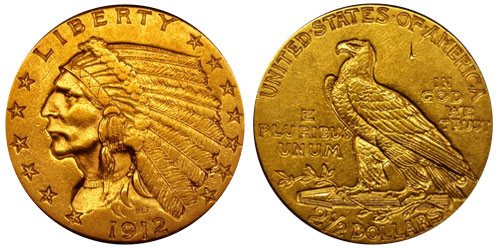Indian Quarter Eagle
Source: My Coin Guides: The Indian Head Quarter Eagle is among the most affordable and collectible of all gold series. The series was introduced in 1908 and concluded in 1933. It is famous for having an incused design instead of raised as seen on the majority of coins. Although the series is now considered to be extremely artistic, there was some opposition when the coins first appeared in circulation, replacing the Liberty quarter eagles that were put into circulation in 1840, more then a generation earlier.

Early in the 20th century President Roosevelt grew increasingly tired with the current coinage in circulation, in particular the gold coinage. All gold coins in circulation, from the quarter eagle to the eagle bore the same basic design, which had been introduced in the 1830’s. The larger denominations, the eagles and double eagles had new designs introduced in 1907. Most people were in agreement that the new designs for these denominations represented major artistic improvements. The next year, the smaller denominations were set to change with the same goal.
Dr. William Sturgis Bigelow, a close friend of President Roosevelt, had suggested using an incuse design for the minor gold coins. Up to that point, all United States coinage had a raised design and rim, although an intaglio design was opted back in 1792. After apparently receiving a positive response from Roosevelt, Bigelow contacted Boston sculptor Bela Lyon Pratt to design the new coins. Born in 1867, Pratt attended Yale University, and after graduation, traveled to France, in particular Paris, to study under well-known French sculptors. After his return in the early 1890s his future work would be widely influenced by this period.
The designs for the Indian Quarter Eagle were finalized in late June of 1908, and production started during the last few months of the year at the Philadelphia Mint. The final design was similar to the newly introduced ten dollar design, but the incuse devices made it look much different. The obverse featured an Indian male chief with a large ceremonial headdress. The word LIBERTY is above, with thirteen stars surrounding and the date below. The reverse features an eagle, perched on a bundle of arrows with an olive branch in its claws. E PLURIBUS UNUM is in the left field, and IN GOD WE TRUST is in the right field. UNITED STATES OF AMERICA is on above, and the denomination, spelled as 2 1/2 DOLLARS is below.
Indian Quarter Eagles circulated extensively, making most pieces available in the Extremely Fine to About Uncirculated grades. Mint State pieces are more difficult to locate, however can be found with some searching. The series contains a single key date makes completion of the set in any condition a challenging endeavor.
Grading these pieces is considered to be the most difficult of all United States coinage, due to the incuse design which do not show much wear. Key features include the eyebrow and feathers on the obverse, and the eagles shoulder on the reverse. Even most Mint State coins will feature some friction on the cheek of the Indian, which is commonly accepted by the grading companies.
